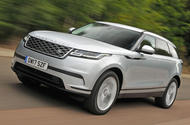
Fourth Range Rover model has abundant style but how much breadth of ability does the Velar really have?
Semi-skimmed is how we’ve previously characterised the Range Rover Velar.Mid-sized is how Land Rover prefers it, the model filling out the obvious white space between the decidedly compact Evoque and the comfortably large Range Rover Sport.But our preferred description refers to more than just the Velar’s dimensions. Unlike its full-sized siblings, the fourth addition to the Range Rover line-up is the product of something other than Gaydon’s full-fat approach to SUVs. Because this new Range Rover is unequivocally car-based.Its predominately aluminium platform is the same architecture used by the latest Jaguar XE and Jaguar XF. The Jaguar F-Pace is an even closer blood relative, despite starting at £10,000 less than the Velar.Naturally, four-wheel drive and Land Rover’s Terrain Response system are both standard, even at the base of the line-up – but so, too, are four-cylinder engines, coil suspension and an usually low ride height for a Range Rover.In this garb, perhaps even more so than the stoutly mechanical Evoque, the Velar smacks of a modern, immodestly expensive crossover – the kind of car many would describe as the antithesis of Land Rover’s usual off-road-capability-centric modus operandi. Taking a view on the philosophy behind the Velar, and where it leaves Gaydon, will be one objective of this road test.At the outset, it’s merely possible to acknowledge a few home truths: the Velar plainly looks the part, can be had with comparatively economical Ingenium engines and can also be bought in entry-level trim from around £15,000 less than a Range Rover Sport.Taken without any additional context, those facts alone ought to guarantee the kind of feverish new-buyer interest that the Evoque generated in 2011.Whether or not that level of attention is actually deserved on a fitness-for-purpose basis will be the second objective of this road test.Range Rover Velar design & stylingOur Velar arrived in HSE trim, which a lot of buyers will consider a minimum requirement for a car that looks like it has not long stepped off of a motor show stand.HSE brings you the 21in wheels that would have seemed ludicrously large just a few years ago but fit the Velar’s concept-like looks to a tee.Car makers talk about identities and design languages: the Velar looks like the ultimate and most successful interpretation of how much more dynamic Range Rover has been trying to make its range. It feels like the zenith; as if Range Rovers hereafter will need a new set of guidelines.Beneath the skin, the Velar is an entirely logical extension of the Range Rover line-up: more rugged than an Evoque, but less so than the Range Rover Sport or full-fat Range Rover.Put simply, the mostly aluminium monocoque it sits on is the same as the Jaguar F-Pace’s. There’s a longitudinal engine in the front – we’ll come back to that – driving through a ZF eight-speed gearbox to all four wheels.Predominantly, the driveline is the same as in Jaguars: it’s a rear-drive car first and foremost, with a clutch at the gearbox that can push power to the front wheels as and when necessary. Which, in a car like a Range Rover, is a lot more than it ought to be necessary in ‘lesser’ off-roaders.There’s no low-ratio gearbox, but there is respectable ground clearance, approach and departure angles and wade depth, particularly on the optional air suspension this car has fitted.All of those numbers are worse than full-sized Range Rovers but also superior to any other car in this sector. What you won’t find on a big Range Rover, mind, but you will here is a four-cylinder diesel engine from the Jaguar Land Rover (JLR) Ingenium line-up.Yes, it makes 237bhp and 369lb ft, which is impressive for a 2.0-litre engine; but, at 2089kg, the Velar is a heavy car for a 2.0-litre engine. We’ll see how it fares in a moment.The Range Rover Velar line-up at a glanceThe Velar range currently consists of three petrol and four diesel models. The P250 and P300 use Land Rover’s turbocharged four-cylinder Ingenium petrol in two separate states of tune, while the D180 and D240 use a similarly-split diesel motor. The step-up D275 and D300 both use V6 diesel engines, while the Velar SVA Dynamic the top of the performance ladder with 5.0-litre V8 producing around 550bhp.
Source: Autocar